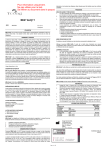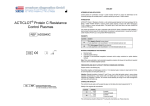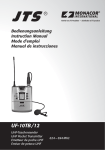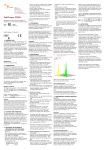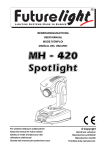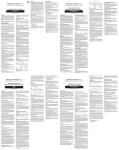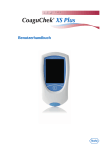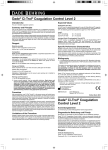Download Pacific Hemostasis® Thromboplastin
Transcript
DEUTSCH ENGLISH • Pacific Hemostasis® Thromboplastin-D I. Intended Use Interfering Substances • • • In multi-center studies Thromboplastin-D was used to assay a normal patient population and yielded the following results: 8 Summary and Principles Instrument Stago STA Amelung KC 4ATM MLATM Electra 1000CTM The PT is used as a screening tool and as a quantitative test for coagulation factors in the extrinsic and common pathways. This test will be prolonged in patients with acquired or congenital disorders that reduce the activity of factors I (fibrinogen), II (Prothrombin), V, VII, and X. The PT is also widely used to monitor oral anticoagulant therapy.1,2 Oral anticoagulants reduce the activity of vitamin-K dependent clotting factors (II, VII, IX, X, Protein C, and Protein S), and the PT is prolonged as a result. Reagent For in vitro diagnostic use. Composition: <0.9% rabbit brain tissue, 0.08% sodium azide, 2% buffers, salts and stabilizers X. Store unopened vials at 2-8ºC. Reconstitute with preservative-free distilled/deionized water according to the Thromboplastin-D vial label, swirl gently and let the vial stand undisturbed for 15 minutes at room temperature. Do not invert the vial or mix vigorously. Reconstitution fluid is available if the quality of water is questionable. After reconstitution, the reagent when stored stoppered is stable for 7 days at 2-8ºC, 8 hours at 37°C. Store at 2-8ºC when not in use. Do not freeze. 8 V. Do not delay mixing the blood with anticoagulant. Avoid foaming the specimen. Use only plastic or siliconized glass containers. Turbid, icteric, lipemic, or hemolyzed specimens may generate erroneous results. Freezing and thawing plasma that contains residual cells will generate damaged cell membranes that can affect results. Acute inflammatory reactions can shorten PT results because of elevated fibrinogen. Plasma samples with hematocrits outside the range of 20-55% may be improperly anticoagulated and should be adjusted appropriately. Factor II 10.9 10.5 10.5 10.9 11.4 13.4 34.0 Materials Provided: Thromboplastin-D Reagent, 10 x 4 mL, 10 x 10 mL, or 10 x 2 mL Thromboplastin D vs. Reagent A, N = 101 Materials Required, But Not Provided: Thromboplastin-D is suitable for use with manual, mechanical, photo-optical, nephelometric, or other means of clot detection. Follow manufacturer’s recommendations for proper use of instrumentation. For manual assays: A. B. C. Prewarm Thromboplastin-D to 37ºC. Add 0.1 mL test plasma to cuvette and prewarm to 37ºC. Forcibly add 0.2 mL warmed Thromboplastin-D to the test plasma and time clot formation. XI. 1. 2. 3. 4. VI. Quality Control Normal and abnormal plasmas such as Pacific Hemostasis Coagulation Control Level 1, 2, and 3 should be tested in conjunction with patient plasmas. Level 1 is a lyophilized normal plasma. Levels 2 and 3 are adjusted to mimic moderately and severely deficient plasmas, respectively. Normal and abnormal controls should be run at the initiation of testing each day and at least once each shift, or with each group of assays. Controls should also be tested with each reagent change or major instrument adjustment. Each laboratory should establish a control group range to represent the allowable variation in day to day performance for each control. VII. Results Prothrombin Time (secs) Factor V Factor VII 11.3 11.2 12.6 12.2 13.1 12.8 13.8 13.5 15.2 14.3 17.6 16.0 55.9 25.9 Factor X 11.4 13.0 13.3 14.5 15.9 19.6 108.8 5. 6. 7. 8-11. PT Correlation R = 0.97 y = 0.7406x + 2.945 Determination of INR International Normalized Ratio (INR). 6,7 Cat. No. 100356 100357 100352 100244 Ordering Information Description Thromboplastin-D Thromboplastin-D Thromboplastin-D Reconstitution Fluid Contents 10 x 4 mL 10 x 10 mL 10 x 2 mL 10 x 10 mL The INR is calculated using the ratio of the patient PT to the mean of a normal reference range (meanNRR) according to the following mathematical relationship: INR = ( Patient PT meanNRR ) ISI For example, with an ISI of 1.95 and a mean normal of 11.9 seconds, the INR for a PT of 20.0 seconds is calculated as follows: INR = ( ) 20.0 11.9 1.95 = (1.68)1.95 = 2.7 The International Sensitivity Index (ISI) is a measure of a thromboplastin/instrument sensitivity to coagulation factors. ISI values are assigned by comparison to a primary reference material. High sensitivity reagents have low ISI values. According to WHO recommendations, INR values above 5.5 place the patient at unnecessary risk for bleeding complications. It is generally advised that patients on stabilized oral anticoagulant therapy should be maintained at an INR of 2.0 – 3.5, depending on the clinical indication.2 The lot specific ISI value for Thromboplastin-D can be found on the kit box label. (For additional instrument ISI values, call Fisher Diagnostics.) VIII. Limitations The biochemistry of coagulation involves a series of reactions that are influenced by many pre-test conditions. These variables must be controlled to obtain reproducible results.3 Technique • pH will increase if plasma is open to air. Store samples stoppered in plastic or siliconized glass. • Plasma held at 4-8ºC may undergo cold activation resulting in significant shortening of the PT.4 • Thromboplastin-D was designed to work at 37ºC ± 0.5ºC. Frequently check the temperature of all heating elements. • All labware must be clean and free of trace amounts of detergents. • • • IX. V. X. Zusammenfassung der Intra-Assay-Präszisionsstudien, % CV (N = 20) Probe % Faktor 100 50 40 30 20 10 0 Thromboplastin-D vs. Reagenz A, N = 101 XI. 1. 2. 3. 4. 5. VII. Ergebnisse 6. 7. Ermittlung des INR-Werts Fisher Diagnostics® Limited Warranty Fisher Diagnostics (FD) warrants to the purchaser only that FD products will perform as described on their labeling and product literature. Purchaser must determine the suitability of FD products for their specific applications. FD’s sole obligation will be, at its option, to either replace a non-conforming or defective product, or return the purchase price. FD DISCLAIMS ALL OTHER WARRANTIES, EXPRESSED OR IMPLIED, INCLUDING THE WARRANTIES OF MERCHANTABILITY AND FITNESS FOR ANY PARTICULAR PURPOSE. Neither FD nor its affiliates shall, in any event, be liable for incidental or consequential loss or damage. All other trademarks are the property of Thermo Fisher Scientific Inc. and its subsidiaries. Amelung KC 4A is a registered trademark of Trinity Biotech. MLA Electra 1000C is a registered trademark of Instrumentation Laboratory. Eine unerwünschte Folge der oralen Antikoagulationstherapie kann eine Tendenz zur vermehrten Blutung sein. Um den gewünschten therapeutischen Effekt zu maximieren und die Blutungen zu minimieren, wurde von der WHO (World Health Organization) ein standardisiertes Verfahren im Hinblick auf die Testausführung und Behandlung empfohlen. Dieses Verfahren basiert auf der INR (International Normalized Ratio).6,7 ( Patienten-PT MittelNRR ) ISI Bei einem ISI (Internationaler Sensitivitäts-Index) von 1,95 und einem mittleren Normalwert von 11,9 Sekunden wird die INR für eine PT von 20,0 Sekunden beispielsweise wie folgt berechnet: INR = ( ) 20,0 11,9 1,95 = (1,68)1,95 = 2,7 Der Internationale Sensitivitäts-Index (ISI) ist drückt die Thromboplastin/Instrument-Empfindlichkeit im Hinblick auf Koagulationsfaktoren aus. ISI-Werte werden mittels eines Vergleichs zum primären Referenzmaterial erhalten. Hoch empfindliche Reagenzien weisen niedrige ISI-Werte auf. Gemäß den WHO-Empfehlungen setzen INR-Werte über 5,5 den Patienten einem unnötigen Risiko von Blutungskomplikationen aus. Es wird im Allgemeinen empfohlen, dass bei Patienten mit einer stabilisierten oralen Antikoagulationstherapie ein INR-Wert von 2,0 - 3,5 beibehalten werden sollte, wobei dies abhängig von der klinischen Indikation ist.2 Der chargenspezifische ISI-Wert für Thromboplastin-D befindet sich auf dem Verpackungsetikett. (Weitere ISI-Werte erhalten Sie bei Fisher Diagnostics.) Prothrombin Time (Sekunden) Faktor V Faktor VII 11,3 11,2 12,6 12,2 13,1 12,8 13,8 13,5 15,2 14,3 17,6 16,0 55,9 25,9 Faktor X 11,4 13,0 13,3 14,5 15,9 19,6 108,8 8-11. PT-Korrelation R = 0,97 y = 0,7406x + 2,945 INR-Korrelation R = 0,96 y = 0,9795x + 0,0029 Referenzen Errichetti, A.M., Holden, A., Ansell, J.: Management of Oral Anticoagulant Therapy: Experience with an Anticoagulation Clinic. Arch Inter Med. 144:1966-68, 1984. Hirsh, J., Dalen, J.E., Deykin, D., Poller, L.: Oral Anticoagulants: Mechanisms of Action, Clinical Effectiveness, and Optimal Therapeutic Range. Chest 102(Suppl): 312S-316S, 1992. NCCLS: Collection, Transport, and Processing of Blood Specimens for Coagulation Testing and General Performance of Coagulation Assays; Approved Guideline. NCCLS Document H21-A4. Wayne, PA, 2003. Palmer, R.N., Gralnick, H.R.: Inhibition of the Cold Activation of Factor VII and the Prothrombin Time. Am J Clin Path. 81: 618-622, 1984. Young, D.S., Thomas, D.W., Friedman, R.B., et al: Effect of Drugs on Clinical Laboratory Tests. Clin Chem 18:1041, 1972. Dalen, J.E., Hirsh, J.: American College of Chest Physicians and the National Heart, Lung, and Blood Institute National Conference on Antithrombotic Therapy. Arch Inter Med. 146:462-472, 1986. Palaereti, G., Coccheri, S., Poggi, M., et al: Oral Anticoagulant Therapy Control: Evidence that the INR Expression Improves the Interlaboratory Comparability of Results. The Bologna Oral Anticoagulant Control Exercise. Thromb Haemostasis 58:905-910, 1987. Daten in 510 (K)-Datei. Die INR wird unter Berücksichtigung des Verhältnisses der Patienten-PT zum Mittelwert eines normalen Referenzbereichs (MittelNRR) gemäß der folgenden mathematischen Beziehung ermittelt: INR = Faktor II 10,9 10,5 10,5 10,9 11,4 13,4 34,0 Korrelation: Die Korrelationsstudien wurden mit einem Kaninchenhirn-Thromboplastin-Reagenz auf dem MLA-1000C ausgeführt. 11 Thromboplastin-D eignet sich für die manuelle, mechanische, photo-optische oder andere Nachweismethoden von Gerinnungssystem. Für eine ordnungsgemäße Anwendung der Instrumente sind die Anweisungen des Herstellers zu beachten. Manuelle Versuche: Zeichnen Sie die Gerinnungszeit für jedes Plasma bis auf 0,1 Sekunden genau auf. Zum Vergleich kann auch ein normaler Referenzbereich herangezogen werden. Die Gerinnungszeiten von kommerziellen Kontrollplasmen zur relativen Gerinnungszeit werden nicht dokumentiert. Die Kontrollen dienen nur der Qualitätskontrolle des Testsystems. Amelung KC 4A 2,0 % 2,1 % Tests der Faktorempfindlichkeit Destilliertes oder deionisiertes Wasser oder Pacific Hemostasis Reconstitution Fluid Stoppuhr oder Zeitgeber Präzisionspipette: 0,1 und 0,2 mL Normale und abnormale Kontrollen, z. B. Pacific Hemostasis Coagulation Control Plasmas, Level 1, 2 und 3. Normale und abnormale Plasmen, z. B. Pacific Hemostasis Coagulation Control Level 1, 2 und 3, sollten zusammen mit Patientenplasmen getestet werden. Level 1 ist ein lyophilisiertes Normalplasma. Level 2 und 3 sind angepasst, um moderat bzw. schwer defizientes Plasma zu imitieren. Bei der Testinitiierung sollten normale und abnormale Kontrolle jeden Tag und mindestens einmal pro Schicht oder mit jeder Versuchsreihe ausgeführt werden. Die Kontrollen sollten auch bei jedem Reagenzwechsel oder einer umfassenden Instrumentenanpassung durchgeführt werden. Jedes Laboratorium sollte einen Kontrollbereich festlegen, der die zulässigen Abweichungen der täglichen Ausführung für alle Kontrollen darlegt. MLA Electra 1000C 0,6 % 1,8 % Empfindlickeit: Thromboplastin-D erkennt Mängel im extrinsischen Gerinnungssystem gemäß dem Prothrombin Time test. Das Testen der Faktorempfindlichkeit wurde durchgeführt, indem gepooltes Normalplasma mit faktordefizienten Plasmaproben verdünnt wurde, so dass die endgültige Faktorkonzentration zwischen 0-100 % lag. Die PT-Tests dieser Proben wurden auf dem MLA-1000C durchgeführt.10 Nicht im Lieferumfang enthaltene aber erforderliche Materialien: Qualitätskontrolle BioMerieux MDA® 0,8 % 0,9 % Normal Abnormal Im Lieferumfang enthaltene Materialien: Thromboplastin-D Reagent, 10 x 4 mL, 10 x 10 mL, oder 10 x 2 mL VI. N 129 30 30 Leistungsmerkmale Testverfahren Thromboplastin-D auf 37 ºC vorwärmen. 0,1 mL Testplasma zur Küvette hinzufügen und auf 37 °C vorwärmen. 0,2 mL vorgewärmtes Thromboplastin-D zum Testplasma hinzufügen und mit einer Stoppuhr messen, wann der Gerinnungsvorgang beginnt. Bereich (+/-2 SD) 10,4–12,2 9,8–13,7 10,4–14,1 Genauigkeit: Die Ergebnisgenauigkeit der Prothrombin Time ist von vielen Faktoren abhängig, z. B. des verwendeten Instrument, der Methode und dem Reagenz. Die Genauigkeit von Thromboplastin-D wurde durch Tests einer normalen und einer abnormalen Plasmaprobe in unterschiedlichen Instrumentarien ermittelt. Die folgende Tabelle enthält eine Zusammenfassung der Ergebnisse.9 Das Mischen des Blutes mit dem Thrombininhibitor sollte sofort erfolgen. Eine Schaumbildung ist zu vermeiden. Nur Behälter aus Kunststoff oder silikonisiertem Glas verwenden. Trübe, ikterische, lipämische oder hämolysierte Proben können fehlerhafte Ergebnisse verursachen. Das Einfrieren und Auftauen von Residualzellen enthaltendem Plasma verursacht eine Beschädigung der Zellmembranen, die sich auf die Ergebnisse auswirken kann. Akute entzündliche Reaktionen können die PT-Ergebnisse aufgrund von erhöhtem Fibrinogen beeinträchtigen. Plasmaproben mit Hämatokritwerten außerhalb eines Bereichs von 20–55 % wurden wahrscheinlich nicht ordnungsgemäß antikoaguliert und sollten entsprechend angepasst werden. A. B. C. PT-Mittelwert (Sekunden) 11,3 11,8 12,2 HINWEIS: Der STA-Normalbereich wurde unter Verwendung frischer Proben festgelegt, alle anderen Instrumentarien mit gefrorenen Proben. Diese Werte sollten nur als Richtlinie verwendet werden. Jedes Labor sollte einen normalen Referenzbereich (NRR) festlegen, der die in diesem Labor verwendeten Instrumente, die Blutentnahmeverfahren und Versuchsmethoden berücksichtigt. Der NRR sollte neu festgelegt oder zumindest überprüft werden, wenn die Chargenummern innerhalb desselben Reagenz geändert werden.3.6 Bei einem Wechsel des Reagenz, der Instrumente, der Blutentnahmeverfahren oder des Thrombininhibitors sollte ein neuer NRR festgelegt werden. Die Gerinnungszeit des abnormalen Plasmas ist abhängig vom ISI-Wert des verwendeten Reagenz. Für Koagulationsversuche werden 3,2 % (0,109 M) des Thrombininhibitors Trinatriumcitrat empfohlen. Hämolyse und Kontamination durch Gewebeflüssigkeiten vermeiden. Proben mit weniger als 90 % des erwarteten Füllvolumens sollten abgelehnt werden. Blut für 15 Minuten bei 1500 x g zentrifugieren. Innerhalb von zwei Stunden testen, wenn die Proben bei 22–24 °C gelagert werden. Wenn der Test nicht innerhalb von 24 Stunden ausgeführt werden kann, sollte das Plasma bei -20 °C bis zu zwei Wochen oder bei -70 °C bis zu 6 Monaten eingefroren werden. Weitere Informationen zur Präparierung und Lagerung der Proben finden Sie im NCCLS Dokument H21-A4.3 • • Erwartete Werte Instrument Stago STA Amelung KC 4ATM MLATM Electra 1000CTM Probenvorbereitung • • • • • Natriumoxalat, EDTA und Heparin sind keine geeigneten Thrombininhibitoren. Die PT kann durch Substanzen wie orale Kontrazeptiva, Corticosteroide, EDTA, Asparaginase, Clofibrat, Erythromycin, Äthanol, Tetracyclin und Antikoagulanzien, z. B. Heparin und Warfarin, verlängert werden.5 Die PT kann durch Substanzen wie Antihistamine, Butabarbital, Koffein, orale Kontrazeptiva, Phenobarbital und Vitamin K verkürzt werden.5 Die Auswertungen von Thromboplastin-D in mehreren Studien einer normalen Patientenpopulation ergab die folgenden Ergebnisse: 8 Warnung: Thromboplastin-D enthält Natriumazid. In saurer Lösung zersetzt sich Natriumazid in Stickstoffwasserstoffsäure, einem ausgesprochen toxischen Stoff. Azidverbindungen sollten vor der Entsorgung mit fließendem Wasser verdünnt werden. Nach der Entsorgung mit viel Wasser nachspülen, um die Azidbildung zu vermeiden. Diese Vorsichtsmaßnahmen werden empfohlen, um Ablagerungen in Metallrohren zu vermeiden, die zu explosionsgefährlichen Bedingungen führen können. IV. Wenn das Plasma Luft ausgesetzt wird, erhöht sich der Plasma-pH-Wert. Proben in Behältern aus Kunststoff oder silikonisiertem Glas verwenden. Bei 4–8 ºC gelagertes Plasma kann eine Aktivierung (Cold Activation) unterlaufe, die eine signifikante Verkürzung der PT zur Folge hat.4 Thromboplastin-D wurde für den Einsatz bei 37 ºC ± 0,5 ºC vorgesehen. Die Temperatur aller Heizelemente muss daher regelmäßig geprüft werden. Alle Instrumente müssen gereinigt und frei von Reinigungsmittelrückständen sein. Für eine ordnungsgemäße Wartung sind die Anweisungen des Herstellers zu beachten. Störende Substanzen Reagenz Vor jeder Verwendung vorsichtig schütteln. Hierzu eine Vorrichtung verwenden, z. B. einen Magnetrüttler, um eine angemessene Aufhängung zu gewährleisten. Fehlendes Vakuum in Flaschen, fehlerhafte Ergebnisse, Qualitätskontrollwerte außerhalb der festgelegten Bereiche oder Abweichungen in der Farbe des Produkts können auf eine Verschlechterung des Produkts hinweisen. Eine mangelhafte Qualität kann jedoch auch durch andere Faktoren innerhalb des Testsystem begründet sein. INR Correlation R = 0.96 y = 0.9795x + 0.0029 References Errichetti, A.M., Holden, A., Ansell, J.: Management of Oral Anticoagulant Therapy: Experience with an Anticoagulation Clinic. Arch Inter Med. 144:1966-68, 1984. Hirsh, J., Dalen, J.E., Deykin, D., Poller, L.: Oral Anticoagulants: Mechanisms of Action, Clinical Effectiveness, and Optimal Therapeutic Range. Chest 102(Suppl): 312S-316S, 1992. NCCLS: Collection, Transport, and Processing of Blood Specimens for Coagulation Testing and General Performance of Coagulation Assays; Approved Guideline. NCCLS document H21-A4. NCCLS, Wayne, PA, 2003. Palmer, R.N., Gralnick, H.R.: Inhibition of the Cold Activation of Factor VII and the Prothrombin Time. Am J Clin Path. 81: 618-622, 1984. Young, D.S., Thomas, D.W., Friedman, R.B., et al: Effect of Drugs on Clinical Laboratory Tests. Clin Chem 18:1041, 1972. Dalen, J.E., Hirsh, J.: American College of Chest Physicians and the National Heart, Lung, and Blood Institute National Conference on Antithrombotic Therapy. Arch Inter Med. 146:462-472, 1986. Palaereti, G., Coccheri, S., Poggi, M., et al: Oral Anticoagulant Therapy Control: Evidence that the INR Expression Improves the Interlaboratory Comparability of Results. The Bologna Oral Anticoagulant Control Exercise. Thromb Haemostasis 58:905-910, 1987. Data found in 510 (K) file. • • Für die Verwendung in der in-vitro-Diagnostik. Amelung KC 4A 2.0% 2.1% Report clotting times for each plasma to the nearest 0.1 second. A Normal Reference Range can also be reported for comparison. Do not report patient values relative to commercial control plasma clotting times. Controls are intended only for quality assurance of the test system. An undesirable consequence of oral anticoagulant therapy may be a tendency to bleed unnecessarily. In order to maximize the desired therapeutic effects and minimize bleeding, the World Health Organization (WHO) has recommended a procedure to standardize testing and treatment. This procedure is based on the III. Correlation: Correlation studies were performed against a competitor rabbit brain thromboplastin reagent on the MLA-1000C instrument. 11 Test Procedure Distilled or Deionized water, or Pacific Hemostasis Reconstitution Fluid Stopwatch or timer Precision pipette: 0.1 and 0.2 mL Normal and abnormal controls such as Pacific Hemostasis Coagulation Control Plasmas, Level 1, 2, and 3 Der einstufige PT berechnet die Gerinnungszeit des Plasmas, nachdem ein Gewebefaktor (Thromboplastin) und Kalzium hinzugegeben wurde. Die Rekalzifikation des Plasmas erzeugt bei vorhandenem Gewebefaktor den aktivierten Faktor Xa (F.Xa). F.Xa aktiviert anschließend Prothrombin zu Thrombin, welches das Fibrinogen in ein nicht lösliches Fibringerinnsel umwandelt. Factor Sensitivity Testing % Factor 100 50 40 30 20 10 0 • Der PT-Test eignet sich als Screening-Tool und als quantitativer Test für die Koagulationsfaktoren im extrinsischen und allgemeinen Gerinnungssystem. Dieser Test wird bei Patienten mit erworbenen oder angeborenen Störungen verlängert, welche die Aktivität der Faktoren I (Fibrinogen), II (Prothrombin), V, VII und X reduzieren. Der PT-Test ist außerdem weit verbreitet zur Monitorisierung der oralen Antikoagulationstherapie verwendet.1,2 Orale Antikoagulanzien reduzieren die Aktivität der Vitamin-K-abhängigen Gerinnungsfaktoren (II, VII, IX, X, Protein C und Protein S) und verursachen eine verlängerte PT-Zeit. Sensitivity: Thromboplastin-D detects deficiencies in the extrinsic pathway as determined by the Prothrombin Time test. Factor sensitivity testing was performed by diluting pooled normal plasma with factor deficient plasmas such that the final factor concentration ranged from 0-100%. PT testing of these samples was performed on the MLA-1000C instrument. 10 3.2% (0.109M) trisodium citrate anticoagulant is recommended for coagulation assays. Avoid hemolysis and contamination by tissue fluids. Samples that have less than 90% of the expected fill volume should be rejected. Centrifuge blood for 15 minutes at 1500 x g. Test within 2 hours if samples are held at 22-24ºC. If testing is not completed within 24 hours, plasma should be frozen at –20°C for up to two weeks or –70°C for up to 6 months. For more details on specimen collection and storage, see NCCLS Document H21-A4.3 • Zusammenfassung und Prinzipien Ungeöffnete Flaschen bei 2–8 °C lagern. Entsprechend der Angaben auf dem Thromboplastin-D -Flaschenetikett wieder in konservierungsstofffreies, destilliertes/deionisiertes Wasser einsetzen, vorsichtige Kreisbewegungen machen und die Flasche 15 Minuten bei Raumtemperatur ruhen lassen. Die Flasche nicht invertieren oder schütteln. Bei bedenklicher Wasserqualität steht eine Rekonstitutionsflüssigkeit zur Verfügung. Nach der Rekonstitution sollte das verschlossen bei 2–8 °C gelagerte Reagenz nach 7 Tagen und bei einer Lagerung einer Temperatur von 37 °C nach 8 Stunden verwendet werden. Bei Nichtverwendung bei 2–8 ºC lagern. Nicht einfrieren.8 Normal Abnormal Specimen Collection • • II. N 129 30 30 Zusammensetzung: <0,9 % Kaninchenhirn, 0,08 % Natriumazid, 2 % Puffer, Salze und Stabilisatoren MLA Electra 1000C 0.6% 1.8% Technische Hinweise Pacific Hemostasis Thromboplastin-D wird eingesetzt zur Durchführung des einstufigen Prothrombinzeit-Tests (PTTest) und für auf PT-basierte Faktor-Assays. Precision: Precision of Prothrombin Time results is dependent on many factors, such as the instrument, technique and the reagent in use. Thromboplastin-D precision was assessed by testing a normal and abnormal plasma on several different instruments. The results are summarized in the following table. 9 BioMerieux MDA® 0.8% 0.9% Die Biochemie der Koagulation umfasst eine Reihe von Reaktionen, die durch viele Bedingungen zur Testvorbereitung beeinflusst werden. Um reprodzierbare Ergebnisse zu erhalten, müssen diese Variablen kontrolliert werden.3 Verwendungszweck Performance Characteristics Sample Warning: Thromboplastin-D contains sodium azide. Sodium azide under acidic conditions yields hydrazoic acid, an extremely toxic compound. Azide compounds should be diluted with running water before being discarded. Upon disposal, azide compounds should be flushed with large volumes of water. These precautions are recommended to avoid deposits in metal pipes in which explosive conditions may develop. • • • • • Range (+/-2SD) 10.4-12.2 9.8-13.7 10.4-14.1 VIII. Grenzen des Verfahrens • I. Summary of Within-run Precision Studies, %CV (N = 20) Mix gently before each use. Provide some mechanism, such as a magnetic stirrer, to maintain adequate suspension during use. Lack of vacuum in vials, erratic results, quality control values outside established ranges, or product color variations could indicate deterioration. However, poor performance could also be due to other factors within the test system. IV. PT Mean(secs) 11.3 11.8 12.2 NOTE: The STA normal range was established using fresh samples, all other instruments with frozen samples. These values should be used as a guideline. Each laboratory should establish a Normal Reference Range (NRR) using instrumentation, blood collection methods, and testing techniques used in that laboratory. The NRR should be reestablished or at least verified when changing lot numbers of the same reagent.3,6 A new NRR should be established with any change in reagents, instrumentation, blood collection techniques, or anticoagulant. The clotting time of abnormal plasmas will depend on the ISI of the reagent lot in use. The one-stage PT measures the clotting time of plasma after adding a source of tissue factor (thromboplastin) and calcium. The recalcification of plasma in the presence of tissue factor generates activated Factor Xa (F.Xa). F.Xa in turn activates Prothrombin to thrombin, which converts fibrinogen to an insoluble fibrin clot. III. Sodium oxalate, EDTA, and heparin are not suitable anticoagulants. The PT may be prolonged by substances such as oral contraceptives, corticosteroids, EDTA, asparaginase, clofibrate, erythromycin, ethanol, tetracycline, and anticoagulants such as heparin and warfarin.5 The PT may be shortened by substances including antihistamines, butabarbital, caffeine, oral cotraceptives, phenobarbital,and vitamin K.5 IX. Expected Values Pacific Hemostasis Thromboplastin-D is intended for use in performing the one-stage prothrombin time (PT) test and PT-based factor assays. II. Pacific Hemostasis Thromboplastin-D Always follow instrument manufacturer’s instructions for proper maintenance. Kat.- Nr. 100356 100357 100352 100244 Bestellinformationen Beschreibung Thromboplastin-D Thromboplastin-D Thromboplastin-D Reconstitution Fluid Inhalt 10 x 4 mL 10 x 10 mL 10 x 2 mL 10 x 10 mL Fisher Diagnostics Gewährleistungssausschluss Fisher Diagnostics (FD) garantiert dem Käufer nur, dass die FD-Produkte die Angaben auf den Etiketten und in der entsprechenden Produktdokumentation erfüllen. Der Käufer muss die spezifische Anwendungstauglichkeit der FD-Produkte selbst ermitteln. FD verpflichtet sich nach eigenem Ermessen ein fehlerhaftes oder unbrauchbares Produkt zu ersetzen oder die Anschaffungskosten zu ersetzen. FD SCHLIESST ALLE ANDEREN GEWÄHRLEISTUNGEN, AUSDRÜCKLICH ODER STILLSCHWEIGEND, EINSCHLIESSLICH DER GEWÄHRLEISTUNGEN DER MARKTGÄNGIGKEIT UND TAUGLICHKEIT FÜR BESTIMMTE ZWECKE AUS. Desweiteren sind weder FD noch ihre Vertreter in keinem Fall haftbar für beiläufig entstandene oder Folgeschäden bzw. -verluste. All other trademarks are the property of Thermo Fisher Scientific Inc. and its subsidiaries. Amelung KC 4A is a registered trademark of Trinity Biotech. MLA Electra 1000C is a registered trademark of Instrumentation Laboratory. FRANÇAIS Pacific Hemostasis Thromboplastin-D I. III. • Utilisation prévue • • • Résumé et principes de base Substances interférentes Le TQ en une seule opération mesure le temps de coagulation du plasma après ajout d’une source de facteur tissulaire (thromboplastine) et de calcium. La recalcification du plasma en présence de facteur tissulaire génère un facteur Xa (F.Xa) activé. Le facteur Xa active à son tour la prothrombine en thrombine, qui convertit le fibrinogène en un caillot fibrineux insoluble. • • • IX. X. Sample % de facteur 100 50 40 30 20 10 0 Eau distillée ou désionisée, ou Pacific Hemostasis Reconstitution Fluid Chronomètre ou minuterie Pipette de précision : 0,1 et 0,2 mL Contrôles normaux et anormaux, tels le Pacific Hemostasis Coagulation Control Plasmas, Level 1, 2 et 3 XI. 1. 2. 3. 4. 5. 6. Noter les temps de coagulation de chaque échantillon de plasma, arrondis au dixième de seconde le plus proche. À titre de comparaison, un intervalle de référence normal peut également être défini. Ne pas comparer les valeurs des patients aux temps de coagulation des contrôles de plasma fournis. Les contrôles ne sont destinés qu’à l’assurance qualité du système de test. 7. Détermination de l’INR 8-11. ( TQ patient moyennePNR ) ISI Par exemple, avec un ISI de 1,95 et une moyenne normale de 11,9 secondes, l’INR d’un TQ de 20,0 secondes se calcule comme suit : INR = ( ) 20,0 11.9 1,95 = (1,68)1,95 = 2,7 L’Indice de sensibilité international (ISI) est une mesure de la sensibilité de l’instrument/de la thromboplastine aux facteurs de coagulation. Les valeurs ISI sont affectées par comparaison avec un matériel de référence. Les réactifs à haute sensibilité présentent des valeurs ISI faibles. Conformément aux recommandations de l’OMS, les valeurs INR supérieures à 5,5 peuvent exposer le patient à des risques inutiles de complications hémorragiques. On admet généralement que les patients sous traitement anticoagulant oral stabilisé doivent conserver un INR entre 2,0 et 3,5, en fonction des indications cliniques.2 La valeur ISI spécifique au lot pour le Thromboplastin-D est indiquée sur l’étiquette de la boîte du kit. Pour connaître les valeurs ISI d’autres instruments, contacter Fisher Diagnostics. VIII. Limites Facteur II 10,9 10,5 10,5 10,9 11,4 13,4 34,0 Thromboplastin D vs. Réactif A, N = 101 Contrôle qualité INR = La Thromboplastin-D de Pacific Hemostasis se utiliza para pruebas de tiempo de protombina de una sola etapa y para la valoración de factores basados en TP. • Resumen y fundamento • • • MLA Electra 1000C 0,6 % 1,8 % Amelung KC 4A 2,0 % 2,1 % • • • IX. En estudios multicéntricos, se utilizó Thromboplastin-D para estudiar una población normal, obteniéndose los siguientes resultados 8: Advertencia: La Thromboplastin-D contiene azida sódica. En un medio ácido, la azida sódica produce ácido hidrazóico, un compuesto muy tóxico. Los compuestos de azida deben diluirse con agua corriente antes de desecharse. Después de desecharlos debe verterse gran cantidad de agua. Se recomienda seguir estas precauciones a fin de evitar la acumulación de residuos en las tuberías de metal, que pueden generar condiciones explosivas. Prothrombin Time (secondes) Facteur V Facteur VII 11,3 11,2 12,6 12,2 13,1 12,8 13,8 13,5 15,2 14,3 17,6 16,0 55,9 25,9 Facteur X 11,4 13,0 13,3 14,5 15,9 19,6 108,8 Corrélation TQ R = 0,97 y = 0,7406 x + 2,945 X. N 129 30 30 Precisión: La precisión de los resultados del Prothrombin Time depende de muchos factores, tales como el instrumento, la técnica y el reactivo utilizados. La precisión de la Thromboplastin-D fue evaluada mediante pruebas con plasma normal y anormal en diferentes instrumentos. Los resultados se indican en la siguiente tabla 9 . Resumen de estudios de precisión intra-serie, %CV (N = 20) Muestra BioMerieux MDA® 0,8 % 0,9 % Normal Anormal MLA Electra 1000C 0,6 % 1,8 % Amelung KC 4A 2,0 % 2,1 % Sensibilidad: La Thromboplastin-D detecta deficiencias en la vía extrínseca, según determina la prueba del tiempo de protombina. La prueba de sensibilidad a los factores se realizó diluyendo plasma normal con plasmas con deficiencia de factor, de tal forma que la concentración del factor final iba de 0 a 100%. Se utilizó un instrumento MLA-1000C para realizar la prueba de TP en las muestras10. Prueba de sensibilidad a los factores % Factor 100 50 40 30 20 10 0 Procedimiento de la prueba Material suministrado: Thromboplastin-D Reagent , 10 x 4 mL, 10 x 10 mL, o 10 x 2 mL Material necesario pero no suministrado: Factor II 10,9 10,5 10,5 10,9 11,4 13,4 34,0 Prothrombin Time (seg.) Factor V Factor VII 11,3 11,2 12,6 12,2 13,1 12,8 13,8 13,5 15,2 14,3 17,6 16,0 55,9 25,9 Factor X 11,4 13,0 13,3 14,5 15,9 19,6 108,8 Agua destilada o desionizada, o Pacific Hemostasis Reconstitution Fluid Cronómetro Pipeta de precisión: 0,1 y 0,2 mL Controles normales y anormales tales como Pacific Hemostasis Coagulation Control Plasmas, Level 1, 2 y 3. Correlación: Se utilizó el MLA-1000C para realizar estudios de correlación frente al reactivo de tromboplastina de cerebro de conejo, de un competidor11. Thromboplastin-D puede utilizarse con métodos de detección de coágulos, manuales, mecánicos, fotoópticos, nefelométricos y otros. Siga las instrucciones del fabricante sobre el uso correcto del instrumento. Para pruebas manuales: Thromboplastin D vs. Reactivo A, N = 101 A. B. C. VI. Intervalo (+/-2DE) 10,4–12,2 9,8–13,7 10,4–14,1 Características de funcionamiento No retrasar la mezcla de la sangre con el anticoagulante. Evitar la formación de espuma en la muestra. Utilizar únicamente recipientes de plástico o de vidrio siliconado. Las muestras turbias, ictéricas, lipémicas o hemolizadas pueden generar resultados erróneos. La congelación y posterior descongelación de plasma con células residuales puede romper las membranas de las células, afectando adversamente a los resultados. Las reacciones inflamatorias agudas pueden acortar los resultados del tiempo de protrombina debido a la elevada tasa de fibrinógeno. Las muestras de plasma con hematocritos fuera del intervalo de 20–55 % pueden no resultar correctamente anticoaguladas y el anticoagulante debe ser ajustado adecuadamente. • V. TP medio (seg.) 11,3 11,8 12,2 NOTA: El intervalo normal de STA se estableció utilizando muestras frescas; con todos los demás instrumentos se utilizaron muestras congeladas. Estos valores sólo deben servir de guía. Cada laboratorio debe establecer su propio intervalo normal de referencia, empleando los instrumentos, métodos de recogida de sangre y las técnicas de análisis utilizados habitualmente. El intervalo normal de referencia debe restablecerse, o al menos comprobarse, cada vez que se cambie de número de lote del mismo reactivo3,6, y un nuevo intervalo normal de referencia debe establecerse cada vez que se cambie el reactivo, el instrumento, las técnicas de recogida de sangre, o el anticoagulante. El tiempo de coagulación de los plasmas anormales dependerá del ISI del reactivo utilizado. Recogida de muestras • Corrélation INR R = 0,96 y = 0,9795 x + 0,0029 Références Errichetti, A.M., Holden, A., Ansell, J.: Management of Oral traitement anticoagulant: Experience with an Anticoagulation Clinic. Arch Inter Med. 144:1966-68, 1984. Hirsh, J., Dalen, J.E., Deykin, D., Poller, L.: Oral Anticoagulants: Mechanisms of Action, Clinical Effectiveness, and Optimal Therapeutic Range. Chest 102(Suppl): 312S-316S, 1992. NCCLS: Collection, Transport, and Processing of Blood Specimens for Coagulation Testing and General Performance of Coagulation Assays; Approved Guideline. NCCLS document H21-A4. NCCLS, Wayne, PA, 2003. Palmer, R.N., Gralnick, H.R.: Inhibition of the Cold Activation of Factor VII and the Prothrombin Time. Am J Clin Path. 81: 618-622, 1984. Young, D.S., Thomas, D.W., Friedman, R.B., et al: Effect of Drugs on Clinical Laboratory Tests. Clin Chem 18:1041, 1972. Dalen, J.E., Hirsh, J.: American College of Chest Physicians and the National Heart, Lung, and Blood Institute National Conference on Antithrombotic Therapy. Arch Inter Med. 146:462-472, 1986. Palaereti, G., Coccheri, S., Poggi, M., et al: Oral Anticoagulant Therapy Control: Evidence that the INR Expression Improves the Interlaboratory Comparability of Results. The Bologna Oral Anticoagulant Control Exercise. Thromb Haemostasis 58:905-910, 1987. Données figurant dans le dossier 510(k). Instrumento Stago STA Amelung KC 4ATM MLATM Electra 1000CTM Para las pruebas de coagulación se recomienda utilizar como anticoagulante, citrato de trisódico al 3,2 % (0,109 M) para las pruebas de coagulación. Evitar la hemólisis y la contaminación por los fluidos tisulares. Rechazar las muestras con volumen de llenado inferior al 90% del volumen esperado. Centrifugar la sangre durante 15 minutos a 1500 x g. Realizar la prueba antes de las 2 horas si las muestras han sido conservadas a 22–24 °C. Si las pruebas no se realizan antes de las 24 horas, congelar el plasma a -20 °C durante un máximo de 2 semanas, o a -70 °C durante un máximo de 6 meses. Para más detalles sobre la recogida y conservación de muestras consulte el documento H21-A4 del NCCLS3. • • • • • Oxalato de sodio, EDTA y heparina no son anticoagulantes adecuados. El uso de sustancias como contraceptivos orales, corticosteroides, EDTA, asparaginasa, clofibrato, eritromicina, etanol, tetraciclina, y anticoagulantes como heparina y warfarina pueden no prolongar el tiempo de protrombina5. Sustancias como antihistamínicos, butabarbital, cafeína, contraceptivos orales, fenobarbital y vitamina K pueden reducir el tiempo de protrombina5. Valores previstos Reactivo Mezclar con cuidado antes de usar el reactivo. Utilizar un dispositivo, como un agitador magnético, para mantener una suspensión adecuada durante el uso. La ausencia de vacío en los frascos, resultados erróneos, valores de control de calidad fuera de los intervalos establecidos, o variaciones del color del producto son indicativos del deterioro del mismo. Sin embargo, un funcionamiento deficiente también puede deberse a otros factores de la prueba. IV. El pH del plasma subirá si éste está en contacto con el aire. Conservar las muestras en recipientes cerrados de plástico o de vidrio siliconado. El plasma que se conserva a 4–8 ºC puede sufrir una activación por el frío, provocando un reducción significativa del tiempo de protrombina4. La Thromboplastin-D está diseñada para ser utilizada a 37 ºC ± 0,5 ºC. Comprobar frecuentemente la temperatura de todos los elementos calefactores. Todo el material de laboratorio debe estar limpio y libre de restos de detergentes. Siga cuidadosamente las instrucciones del fabricante sobre el mantenimiento correcto del instrumento. Sustancias interferentes Conservar los frascos sin abrir a 2–8 °C. Reconstituir con agua destilada/desionizada sin conservantes, conforme a las instrucciones indicadas en la etiqueta del frasco de Thromboplastin-D , girar lentamente y dejarlo reposar el vial durante 15 minutos a temperatura ambiente. No invertir el frasco ni agitarlo vigorosamente. Puede utilizarse líquido de reconstitución, que está disponible, si se duda de la calidad del agua. Tras la reconstitución, el reactivo puede conservarse bien tapado durante 7 días a una temperatura entre 2 y 8 ºC, y durante 8 horas a 37 °C. Almacenar a 2–8 ºC cuando no se use. No congelar 8. Corrélation : Les études de corrélation ont été effectuées avec un réactif thromboplastine de cerveau de lapin concurrent, sur l’instrument MLA-1000C. 11 La Thromboplastin-D peut être des utilisée avec des instruments à détection de caillots, qu’ils soient manuels, mécaniques, à cellule photoélectrique, néphélémétriques ou de tout autre type. Suivre les recommandations du fabricant pour utiliser correctement les instruments. Pour les dosages manuels : la relation mathématique suivante : • Composición: <0,9 % de tejido de cerebro de conejo, azida sódica al 0,08 %, soluciones tampón al 2 %, sales y estabilizadores. Test de sensibilité au facteur Matériel nécessaire mais non fourni : Les traitements anticoagulants oraux peuvent avoir des effets indésirables tels une tendance au saignement. Afin d’optimiser les effets thérapeutiques et de minimiser les saignements, l’Organisation mondiale de la Santé (OMS) a recommandé une procédure de standardisation des tests et des traitements. Cette procédure est basée sur le Rapport international normalisé (INR). 6,7 L’INR est calculé à l’aide du ratio TQ patient / moyenne d’une plage de référence normale (moyennePNR), d’après N 129 30 30 Sensibilité : La Thromboplastin-D détecte les déficiences de la voie extrinsèque telles que déterminées par le Prothrombin Time test. Le test de la sensibilité au facteur a été effectué en diluant des pools d’échantillons de plasma normal avec du plasma présentant un déficit en facteur, de sorte que la concentration finale du facteur soit comprise entre 0 et 100 %. Le test TQ de ces échantillons a été effectué sur l’instrument MLA-1000C.10 Procédure de test VII. Résultats BioMerieux MDA® 0,8 % 0,9 % Normal Anormal Mélanger sans délai le sang et les anticoagulants. Éviter la formation de mousse dans l’échantillon. N’utiliser que des récipients en plastique ou en verre siliconé. Les échantillons troubles, ictériques, lipidiques ou hémolysés peuvent donner des résultats erronés. Les échantillons de plasma congelés ou en cours de décongélation qui contiennent des cellules résiduelles produiront des membranes cellulaires abîmées qui peuvent altérer les résultats. Des réactions inflammatoires aiguës peuvent raccourcir le TQ à cause d’un taux élevé de fibrinogène. Les échantillons de plasma affichant des taux d’hématocrite inférieurs à 20 % et supérieurs à 55 % sont susceptibles d’être mal traités par anticoagulant, et doivent être corrigés en conséquence. Les contrôles normaux et anormaux, tels les plasmas de Pacific Hemostasis Coagulation Control, Level 1, 2 et 3 doivent être analysés en association avec les échantillons de plasma des patients. Le Level 1 est un plasma normal lyophilisé. Les Levels 2 et 3 sont conçus pour reproduire les échantillons de plasma légèrement et fortement déficients respectivement. Des contrôles normaux et anormaux doivent être effectués quotidiennement en début d’analyse, et au moins une fois lors de chaque utilisation, ou avec chaque groupe d’analyses. Les contrôles doivent également être testés avec chaque nouveau réactif, ou après chaque réglage important des instruments. Chaque laboratoire doit définir l´intervalle pour chaque groupe de contrôle afin de représenter les variations autorisées dans les résultats au jour le jour, pour chaque contrôle. Plage (+/-2 ET) 10,4–12,2 9,8–13,7 10,4–14,1 Caractéristiques de performance Matériel fourni : Thromboplastin-D Reagent, 10 x 4 mL, 10 x 10 mL, ou 10 x 2 mL VI. Moyenne TQ (secondes) 11,3 11,8 12,2 Résumé des études de précision par test, % CV (N = 20) Il est recommandé d’ajouter 3,2 % (0,109 M) de citrate trisodique comme anticoagulant lors des tests de coagulation. Éviter l’hémolyse et la contamination par des liquides tissulaires. Les échantillons qui atteignent moins de 90 % du volume de remplissage escompté doivent être éliminés. Centrifuger le sang pendant 15 minutes à 1500 x g. Effectuer le test dans les 2 heures si les échantillons sont conservés entre 22 et 24 °C. Si le test n’est pas effectué dans les 24 heures, le plasma doit être congelé à -20 °C pendant deux semaines maximum ou à 70 °C pendant 6 mois maximum. Pour plus de détails sur le prélèvement d’échantillon et le stockage, consulter le Document H21-A4 de la NCCLS.3 Préchauffer la Thromboplastin-D à 37 °C. Ajouter 0,1 mL de plasma à analyser dans la cuvette et préchauffer à 37 °C. Ajouter 0,2 mL de Thromboplastin-D préchauffée au plasma et chronométrer la formation des caillots. III. Précision : La précision des résultats de Prothrombin Time dépend de nombreux facteurs, tels l’instrument, la technique et le réactif utilisés. La précision de la Thromboplastin-D a été vérifiée par des tests sur plasma normal et anormal, sur différents instruments. Les résultats sont résumés dans le tableau suivant.9 Prélèvement d’échantillon A. B. C. Técnica Uso previsto El proceso de medición del tiempo de protrombina en una etapa única mide el tiempo de coagulación del plasma después de la adición del factor tisular (tromboplastina) y del calcio. La recalcificación del plasma en presencia del factor tisular genera el factor Xa activado. A su vez, el factor Xa activa el paso de la protrombina a trombina que convierte el fibrinógeno en un coágulo de fibrina insoluble. les autres instruments, à l’aide d’échantillons congelés. Ces valeurs doivent être utilisées à titre indicatif. Chaque laboratoire doit élaborer une plage de référence normale (PRN), en utilisant les instruments, les méthodes de prélèvement sanguin et les techniques de test qui lui sont propres. La PNR doit être mise à jour, ou tout du moins vérifiée, en cas de changement du numéro de lot d’un même réactif.3 Tout changement de réactif, d’instruments, de technique de prélèvement sanguin ou d’anticoagulants implique l’élaboration d’une nouvelle PNR. Le temps de coagulation de échantillons de plasma anormaux dépend de l’ISI du lot de réactif utilisé. Mélanger doucement avant utilisation. Prévoir un système de type agitateur magnétique, pour conserver une suspension adaptée au cours de l’utilisation. Un manque de vide dans les flacons, des résultats aberrants, des valeurs de contrôle qualité en dehors des plages établies ou des variations de couleur du produit peuvent indiquer une détérioration. Cependant, d’autres facteurs relatifs au système de test peuvent être à l’origine de résultats médiocres. V. El procesos bioquímico de la coagulación implica una serie de reacciones que están influenciadas por múltiples condiciones previas a la prueba. Es necesario controlar estas variables si se desea obtener resultados reproductibles3. El tiempo de protrombina se utiliza como prueba discriminativa y como prueba cuantitativa para determinar los factores de coagulación en las vías extrínseca y común. Esta prueba se prolonga en pacientes con trastornos adquiridos o congénitos que reducen la actividad de los factores I (fibrinógeno), II (Protrombina), V, VII y X. El tiempo de protrombina también se utiliza para controlar los tratamientos con anticoagulante por vía oral1,2 . Los anticoagulantes administrados por vía oral reducen la actividad de los factores de coagulación vitamina K dependientes (II, VII, IX, X, Proteína C y Proteína S), dando como resultado la prolongación del tiempo de protrombina. Valeurs escomptées Instrument Stago STA Amelung KC 4ATM MLATM Electra 1000CTM Stocker les flacons non ouverts entre 2 et 8 °C. Reconstituer avec de l’eau distillée/désionisée sans conservateur, conformément à l’étiquette du flacon Thromboplastin-D , agiter doucement et laisser le flacon reposer pendant 15 minutes à température ambiante. Ne pas retourner le flacon, ni l´agiter brusquement. Du liquide de reconstitution est disponible si la qualité de l’eau est douteuse. Après reconstitution, le réactif est stable pendant 7 jours s’il est stocké rebouché entre 2 et 8 °C, et pendant 8 heures à 37 °C. Stocker entre 2 et 8 °C lorsqu’il n’est pas utilisé. Ne pas congeler. 8 • • II. VIII. Limitaciones Para uso diagnóstico in vitro. Composition : <0,9 % de tissu cérébral de lapin, 0,08 % d’azide de sodium, 2 % de tampons, sels et stabilisateurs. • • • • • I. L’oxalate de sodium, l’EDTA et l’héparine ne sont pas des anticoagulants appropriés. Le TQ peut être prolongé par des substances tels les contraceptifs oraux, les corticostéroïdes, l’EDTA, l’asparaginase, le clofibrate, l’érythromycine, l’éthanol, la tétracycline et les anticoagulants de type héparine et warfarine.5 Le TQ peut être raccourci par différentes substances, notamment les antihistaminiques, le butabarbital, la caféine, les contraceptifs oraux, le phénobarbital et la vitamine K.5 Lors d’études menées dans différents sites, le Thromboplastin-D a été utilisé pour des dosages chez des patients sains et a donné les résultats suivants : 8 REMARQUE : La plage normale STA a été déterminée à l’aide d’échantillons fraîchement prélevés, et pour tous Réactif Pour utilisation diagnostique in vitro. IV. Le pH augmente si le plasma est exposé à l’air. Stocker les échantillons rebouchés dans des récipients en plastique ou en verre siliconé. Le plasma conservé entre 4 et 8 °C peut subir une activation par le froid, ce qui peut générer une diminution significative du TQ.4 Le Thromboplastin-D a été conçu pour être utilisé à 37 °C ± 0,5 °C. Vérifier fréquemment la température de tous les éléments chauffants. Tout le matériel de laboratoire doit être propre et exempt de toute trace de détergent. Respecter scrupuleusement les indications du fabricant en matière d’entretien. Le test TQ sert d’outil de dépistage et comme dosage quantitatif des facteurs de coagulation des voies intrinsèques et communes. Ce test est prolongé chez les patients souffrant de troubles acquis ou congénitaux réduisant l’activité des facteurs I (fibrinogène), II (prothrombine), V, VII et X. Le TQ est également largement utilisé pour surveiller le traitement anticoagulant oral.1,2 Les anticoagulants oraux réduisent l’activité des facteurs de coagulation dépendants de la vitamine K (II, VII, IX, X, protéine C et protéine S), ce qui prolonge d’autant le TQ. Attention : Le test Thromboplastin-D contient de l’azide de sodium. Dans un environnement acide, l’azide de sodium produit de l’acide hydrazoïque, composé extrêmement toxique. Les composés à base d’azide doivent être dilués à l’eau courante avant d’être éliminés. Au moment de les éliminer, les composés à base d’azide doivent être dilués dans de grandes quantités d’eau. Ces précautions sont indispensables pour éviter les dépôts dans les conduites métalliques, qui peuvent produire des composés explosifs. Pacific Hemostasis Thromboplastin-D Technique • Le test Pacific Hemostasis® Thromboplastin-D est destiné à être utilisé dans le cadre de la mesure du TQ (temps de Quick) en une seule opération, ainsi que lors des tests de facteur basés sur le TQ. II. ESPAÑOL La biochimie de la coagulation implique une série de réactions influencées par diverses conditions préalables au test. Ces variables doivent être contrôlées afin d’obtenir des résultats reproductibles.3 Calentar Thromboplastin-D a 37 ºC. Poner 0,1 mL de plasma de prueba en la cubeta y precalentar a 37 °C. Añadir con fuerza 0,2 mL de Thromboplastin-D al plasma de prueba y cronometrar hasta la formación del coágulo. Control de calidad VII. Resultados XI. Bibliografía Errichetti, A.M., Holden, A., Ansell, J.: Management of Oral Anticoagulant Therapy: Experience with an Anticoagulation Clinic. Arch Inter Med. 144:1966-68, 1984. Hirsh, J., Dalen, J.E., Deykin, D., Poller, L.: Oral Anticoagulants: Mechanisms of Action, Clinical Effectiveness, and Optimal Therapeutic Range. Chest 102(Suppl): 312S-316S, 1992. NCCLS: Collection, Transport, and Processing of Blood Specimens for Coagulation Testing and General Performance of Coagulation Assays; Approved Guideline. NCCLS document H21-A4. NCCLS, Wayne, PA, 2003. Palmer, R.N., Gralnick, H.R.: Inhibition of the Cold Activation of Factor VII and the Prothrombin Time. Am J Clin Path. 81: 618-622, 1984. Young, D.S., Thomas, D.W., Friedman, R.B., et al: Effect of Drugs on Clinical Laboratory Tests. Clin Chem 18:1041, 1972. Dalen, J.E., Hirsh, J.: American College of Chest Physicians and the National Heart, Lung, and Blood Institute National Conference on Antithrombotic Therapy. Arch Inter Med. 146:462-472, 1986. Palaereti, G., Coccheri, S., Poggi, M., et al: Oral Anticoagulant Therapy Control: Evidence that the INR Expression Improves the Interlaboratory Comparability of Results. The Bologna Oral Anticoagulant Control Exercise. Thromb Haemostasis 58:905-910, 1987. Información procedente de un archivo de 510(K). 3. 4. 5. 6. 7. Informar, para cada plasma, de los tiempos de coagulación de cada plasma a la décima de segundo más próxima. También puede indicarse el intervalo de referencia normal para comparación. No informar de los valores de los pacientes relacionados con los tiempos de coagulación del plasma de control comercial. Dichos controles sólo se utilizan como garantía de calidad del sistema de prueba. Correlación de INR R = 0,96 y = 0,9795x + 0,0029 1. 2. Plasmas normales y anormales tales como los plasmas de Pacific Hemostasis Coagulation Control, Level 1, 2 y 3 de, deben ser analizados junto con el plasma de los pacientes. El Level 1 es plasma normal liofilizado. Los Levels 2 y 3 han sido ajustados para simular plasmas moderadamente y seriamente deficientes, respectivamente. Deben realizarse controles de plasma normal y anormal cada día al inicio de la pruebas y al menos una vez en cada turno, o con cada grupo de ensayos. Asimismo, los controles deben ser analizados con cada cambio de reactivo o cada vez que se haga un ajuste importante del instrumento. Cada laboratorio debe establecer un intervalo de control que representa la variación diaria permisible para cada control. Correlación de TP R = 0,97 y = 0,7406x + 2,945 8-11. Determinación del cociente internacional normalizado (INR) Réf. Cat. 100356 100357 100352 100244 Pour commander Description Thromboplastin-D Thromboplastin-D Thromboplastin-D Reconstitution Fluid Contenu 10 x 4 mL 10 x 10 mL 10 x 2 mL 10 x 10 mL Garantie limitée de Fisher Diagnostics Fisher Diagnostics (FD) garantit à l’acquéreur le bon fonctionnement des produits FD, tel que décrit sur l’étiquette et dans les modes d’emploi. Il revient à l’acquéreur de décider si les produits FD sont adaptés à ses besoins spécifiques. La seule obligation de FD consiste soit à remplacer un produit non conforme ou défectueux, soit à rembourser le prix d’achat, à sa discrétion. FD DÉCLINE TOUTE RESPONSABILITÉ QUANT AUX AUTRES GARANTIES, EXPLICITES OU IMPLICITES, Y COMPRIS LES GARANTIES DE COMMERCIABILITÉ, ET L’ADÉQUATION DU PRODUIT À TOUTE AUTRE UTILISATION. FD, ni aucune de ses filiales, ne peut en aucun cas être tenue pour responsable d’un incident entraînant une perte ou un dommage quelconque. All other trademarks are the property of Thermo Fisher Scientific Inc. and its subsidiaries. Amelung KC 4A is a registered trademark of Trinity Biotech. MLA Electra 1000C is a registered trademark of Instrumentation Laboratory. Una consecuencia no deseada del tratamiento con anticoagulantes orales, puede ser la tendencia a hemorragias. Para maximizar los efectos terapéuticos deseados y minimizar la hemorragia, la OMS ha recomendado un procedimiento para normalizar las pruebas y el tratamiento. Este procedimiento se basa en el cociente internacional normalizado (INR) 6,7. El INR se calcula relacionando el tiempo de protrombina del paciente con la media de un intervalo de referencia normal (NRRmedio), con la siguiente formula matemática: INR = ( ) TP del paciente NRRmedio ( ) 20,0 11,9 Información para pedidos Descripción Thromboplastin-D Thromboplastin-D Thromboplastin-D Reconstitution Fluid Contenido 10 x 4 mL 10 x 10 mL 10 x 2 mL 10 x 10 mL ISI Por ejemplo, con un valor de ISI de 1,95 y una media normal de 11,9 segundos, el INR de un tiempo de protrombina de 20,0 se calcula de la siguiente forma: INR = Nº de ref. 100356 100357 100352 100244 1,95 = (1,68)1,95 = 2,7 El índice internacional de sensibilidad (ISI) es una medida de la respuesta de tromboplastina/sensibilidad del instrumento a los factores de coagulación. Los valores de ISI se asignan mediante comparación a un material de referencia primario. Los reactivos de alta sensibilidad tienen bajos valores ISI. Según las recomendaciones de la OMS, los valores de INR superiores a 5,5 exponen el paciente a riesgos innecesarios debido a complicaciones hemorrágicas. Generalmente se aconseja que los pacientes con un tratamiento con anticoagulante oral estabilizado sean mantenidos a un INR de 2,0 – 3,5, según las indicaciones clínicas2. El valor de ISI específico a cada lote de Thromboplastin-D está indicado en la etiqueta de la caja. (Póngase en contacto con Fisher Diagnostics si necesita valores ISI adicionales de los instrumentos.) GARANTÍA LIMITADA DE FISHER DIAGNOSTICS Fisher Diagnostics (FD) garantiza al comprador que sólo los productos de Fisher Diagnostics funcionarán tal y como se describe en sus etiquetas y documentación. El comprador debe determinar si los productos de Fisher Diagnostics son idóneos para sus aplicaciones específicas. La única obligación de Fisher Diagnostics será, a su elección, la sustitución de un producto defectuoso o que no cumpla con las especificaciones, o bien la devolución del precio de compra. FD RECHAZA CUALQUIER OTRA GARANTÍA, SEA EXPRESA O IMPLÍCITA, INCLUYENDO LAS GARANTÍAS DE COMERCIABILIDAD E IDONEIDAD PARA UN PROPÓSITO INDIVIDUAL. Ni FD ni sus afiliados podrán ser considerados responsables, en ningún caso, por las pérdidas o daños incidentales o consecuentes. All other trademarks are the property of Thermo Fisher Scientific Inc. and its subsidiaries. Amelung KC 4A is a registered trademark of Trinity Biotech. MLA Electra 1000C is a registered trademark of Instrumentation Laboratory. ITALIANO Pacific Hemostasis Thromboplastin-D I. II. Tecnica • • • Uso previsto • • La Pacific Hemostasis Thromboplastin-D può essere utilizzata per eseguire il Prothrombin Time test e per le analisi basate su PT. Sostanze interferenti Riepilogo e principi del test Il PT viene utilizzato come strumento di screening e come test quantitativo per i fattori di coagulazione nei percorsi estrinseco e comune. Questo tempo di test è prolungato nei pazienti affetti da patologie congenite o acquisite che riducono l’attività dei fattori I (fibrinogeno), II (protrombina), V, VII e X. Il PT viene, inoltre, largamente utilizzato per monitorare la terapia anticoagulante per via orale.1,2 Gli anticoagulanti assunti per via orale riducono l’attività della vitamina K in base ai fattori di coagulazione (II, VII, IX, X, proteina C e proteina S) con conseguente prolungamento del PT. • • • IX. Per diagnostica in vitro. Composizione: <0,9 % tessuto cerebrale di coniglio, 0,08 % sodio azide, 2 % tamponi, sali e stabilizzatori. X. Campione Non ritardare la miscelazione del sangue con l’anticoagulante. Evitare la formazione di schiuma nei campioni. Utilizzare esclusivamente contenitori di vetro siliconati oppure in plastica. I campioni torbidi, itterici, lipoidei oppure emolizzati potrebbero dare luogo a risultati errati. Il congelamento e lo scongelamento del plasma contenente cellule residue può danneggiare le membrane delle cellule compromettendo i risultati. Reazioni infiammatorie acute possono ridurre il valore del PT a causa dell’aumentata quantità di fibrinogeno. Campioni di plasma con ematocrito non compreso tra 20–55 % potrebbero non rispondere correttamente al test di coagulazione e dovranno essere opportunamente corretti. % Fattore 100 50 40 30 20 10 0 Materiali necessari, ma non in dotazione: Acqua distillata o deionizzata oppure Pacific Hemostasis Reconstitution Fluid Cronometro o timer Pipetta di precisione: 0,1 e 0,2 mL Controlli normali ed anormali quali campioni di Pacific Hemostasis Coagulation Control Plasmas, Level 1, 2 e 3 Controllo della qualità Insieme al campione di plasma del paziente testare sempre anche i campioni di plasma normale ed anormale quali i campioni di Pacific Hemostasis Coagulation Control, Level 1, 2 e 3. Il Level 1 corrisponde ad un plasma normale liofilizzato. I Levels 2 e 3 vengono corretti per simulare, rispettivamente, plasma con deficit moderati e gravi. Prima di iniziare i test ogni giorno ed almeno una volta ad ogni cambio di turno oppure con ciascun gruppo di test, procedere al controllo normale e anormale. È necessario, inoltre, procedere ad un test dei controlli ad ogni cambio del reagente oppure in occasione di importanti regolazioni della strumentazione. Ciascun laboratorio è tenuto a stabilire un range di controllo che rappresenti la variazione ammessa nelle prestazioni giornaliere per ciascun controllo. VII. Risultati XI. 1. L’INR viene calcolato utilizzando il rapporto tra il PT del paziente ed il valore medio del range di riferimento normale (mediaNRR) in base alla seguente relazione matematica: INR = ( PT paziente mediaNRR ) ISI Ad esempio, con un ISI pari a 1,95 ed il valore medio normale pari a 11,9 secondi, l’INR relativo ad un PT pari a 20,0 secondi viene calcolato come segue: INR = ( ) 20,0 11,9 1,95 = (1,68)1,95 = 2,7 L’International Sensitivity Index (ISI, indice internazionale di sensibilità) misura la sensibilità della strumentazione/tromboplastina ai fattori di coagulazione. I valori ISI vengono assegnati in rapporto ad un materiale di riferimento primario. I reagenti altamente sensibili presentano dei valori ISI bassi. Conformemente alle raccomandazioni dell’OMS, i valori INR superiori a 5,5 espongono il paziente al rischio di complicanze emorragiche. È generalmente noto che i pazienti in terapia anticoagulante per via orale stabilizzata debbano mantenere un valore di INR pari a 2,0 – 3,5, a seconda delle indicazioni cliniche.2 Il valore ISI relativo alla Thromboplastin-D specifico del lotto è riportato sull’etichetta della scatola del kit (per ulteriori valori ISI della strumentazione contattare Fisher Diagnostics). VIII. Limitazioni L’analisi biochimica della coagulazione comprende una serie di reazioni influenzate da numerose condizioni preesistenti all’analisi. Per ottenere risultati riproducibili è necessario controllare tali variabili.3 MLA Electra 1000C 0,6 % 1,8 % LOT Lot Number Chargenummer Numéro de lot Número de lote Numero di lotto Amelung KC 4A 2,0 % 2,1 % Prothrombin Time (sec.) Fattore V Fattore VII 11,3 11,2 12,6 12,2 13,1 12,8 13,8 13,5 15,2 14,3 17,6 16,0 55,9 25,9 Use By Verfallsdatum Utiliser jusque Fecha de caducidad Da utilizzare entro 2. 3. 4. 5. 6. 8-11. Correlazione PT R = 0,97 y = 0,7406x + 2,945 N. cat. 100356 100357 100352 100244 Informazioni per gli ordini Descrizione Thromboplastin-D Thromboplastin-D Thromboplastin-D Reconstitution Fluid Temperature Limitation Temperatureinschränkungen Limite de température Límite de temperatura Limiti di temperatura Fattore X 11,4 13,0 13,3 14,5 15,9 19,6 108,8 CE Mark CE-Markierung Marquage CE Marca CE Marchio CE REF Correlazione INR R = 0,96 y = 0,9795x + 0,0029 Bibliografia Errichetti, A.M., Holden, A., Ansell, J.: Management of Oral Anticoagulant Therapy: Experience with an Anticoagulation Clinic. Arch Inter Med. 144:1966-68, 1984. Hirsh, J., Dalen, J.E., Deykin, D., Poller, L.: Oral Anticoagulants: Mechanisms of Action, Clinical Effectiveness, and Optimal Therapeutic Range. Chest 102(Suppl): 312S-316S, 1992. NCCLS: Collection, Transport, and Processing of Blood Specimens for Coagulation Testing and General Performance of Coagulation Assays; Approved Guideline. NCCLS document H21-A4. NCCLS, Wayne, PA, 2003. Palmer, R.N., Gralnick, H.R.: Inhibition of the Cold Activation of Factor VII and the Prothrombin Time. Am J Clin Path. 81: 618-622, 1984. Young, D.S., Thomas, D.W., Friedman, R.B., et al: Effect of Drugs on Clinical Laboratory Tests. Clin Chem 18:1041, 1972. Dalen, J.E., Hirsh, J.: American College of Chest Physicians and the National Heart, Lung, and Blood Institute National Conference on Antithrombotic Therapy. Arch Inter Med. 146:462-472, 1986. Palaereti, G., Coccheri, S., Poggi, M., et al: Oral Anticoagulant Therapy Control: Evidence that the INR Expression Improves the Interlaboratory Comparability of Results. The Bologna Oral Anticoagulant Control Exercise. Thromb Haemostasis 58:905-910, 1987. Informazioni ottenute dal file 510(k). Determinazione dell’INR Un effetto indesiderato della terapia anticoagulante per via orale potrebbe essere rappresentato da una tendenza a sanguinare. Per massimizzare gli effetti terapeutici desiderati e ridurre al minimo il sanguinamento, la World Health Organization (WHO) consiglia una procedura per standardizzare il test ed il trattamento. Questa procedura si basa sull’International Normalized Ratio (INR).6,7 Fattore II 10,9 10,5 10,5 10,9 11,4 13,4 34,0 Thromboplastin-D rispetto Reagente A, N = 101 7. Arrotondare i tempi di coagulazione relativi a ciascun campione di plasma allo 0,1 secondi più vicino. È possibile, inoltre, indicare un range di riferimento normale (NRR, Normal Reference Range) per effettuare la comparazione. Non annotare i valori del paziente relativi a tempi di coagulazione del plasma di controllo commerciali. I controlli servono esclusivamente a garantire la qualità del sistema di analisi. BioMerieux MDA® 0,8 % 0,9 % Correlazione: gli studi sulla correlazione sono stati eseguiti con lo strumento MLA-1000C su un reagente di tromboplastina di cervello di coniglio di un altro produttore.11 La Thromboplastin-D è indicata per il rilevamento dei coaguli manuale, meccanico, foto-ottico, nefelometrico oppure di altro tipo. Per un corretto utilizzo della strumentazione attenersi alle raccomandazioni della ditta produttrice. Per le analisi manuali: VI. In Vitro Diagnostic Medical Device Medizinprodukt für die in-vitro-Diagnostik Matériel médical pour utilisation diagnostique in vitro Dispositivo médico para diagnóstico in vitro Dispositivo medico per diagnosi in vitro Verifica della sensibilità al fattore Materiali in dotazione: Thromboplastin-D Reagent, 10 x 4 mL, 10 x 10 mL, oppure 10 x 2 mL Preriscaldare la Thromboplastin-D a 37 °C. Aggiungere 0,1 mL di plasma per test nella cuvetta e preriscaldare a 37 °C. Aggiungere 0,2 mL di Thromboplastin-D riscaldata al plasma del test e cronometrare il tempo di formazione dei coaguli. IVD Sensibilità: la Thromboplastin-D rileva i deficit nel percorso estrinseco come determinato del Prothrombin Time test. La verifica della sensibilità è stata eseguita diluendo un campione di plasma normale combinato con campioni di plasma carenti in modo da ottenere una concentrazione finale compresa tra 0 e 100 %. La verifica del PT di tali campioni è stata eseguita con lo strumento MLA-1000C.10 Procedura del test A. B. C. Symbols Key Manufacturer Hersteller Fabricant Fabricante Fabbricante Caratteristiche delle prestazioni Normale Anormale Per il test sulla coagulazione si raccomanda l’uso dell’anticoagulante al citrato trisodico al 3,2 % (0,109 M). Evitare l'emolisi e la contaminazione da parte dei liquidi tissutali. Non utilizzare i campioni con un volume di riempimento previsto inferiore al 90 %. Centrifugare il sangue per 15 minuti a 1500 x g. Nel caso in cui i campioni siano mantenuti a una temperatura di 22–24 °C, eseguire immediatamente l'analisi. Se il test non viene completato entro 24 ore, è necessario congelare il plasma a -20 °C per un max. di 2 settimane oppure a -70 °C fino a 6 mesi. Per ulteriori dettagli circa la raccolta e la conservazione dei campioni vedere il documento NCCLS H21-A4.3 V. N 129 30 30 Riepilogo degli studi di precisione intra-analisi, %CV (N = 20) Raccolta dei campioni • • Range (+/-2DS) 10,4–12,2 9,8–13,7 10,4–14,1 Precisione: la precisione dei risultati del Prothrombin Time dipende da numerosi fattori tra cui la strumentazione, la tecnica ed il reagente utilizzati. La precisione della Thromboplastin-D deve essere accertata testando su diversi strumenti un campione di plasma normale ed uno anormale. I risultati sono stati riassunti nella seguente tabella:9 Avvertenza: la Thromboplastin-D contiene sodio azide. Il sodio azide in condizioni acide rilascia acido idrazoico, un componente altamente tossico. Prima di smaltire i composti di azide diluirli con acqua corrente. Per smaltire i composti di azide sciacquarli con abbondante acqua. Queste precauzioni servono ad impedire la formazione di depositi nelle tubazioni metalliche in cui potrebbero svilupparsi delle condizioni esplosive. • • • • • PT medio (sec.) 11,3 11,8 12,2 NOTA: il range STA normale è stato determinato utilizzando campioni freschi, per tutti gli altri strumenti sono stati utilizzati campioni congelati. Questi valori vanno considerati come linee guida. Ciascun laboratorio deve stabilire un range di riferimento normale (NRR) in base alla strumentazione, i metodi di raccolta del sangue e le tecniche di analisi utilizzati in tale laboratorio. Il NRR deve essere nuovamente stabilito o verificato almeno ad ogni cambio del numero di lotto dello stesso reagente.3.6 Stabilire un nuovo NRR ad ogni cambio di reagente, strumentazione, tecniche di raccolta del sangue o di anticoagulante. Il tempo di coagulazione del plasma anormale dipende dall’ISI del lotto di reagente in uso. Conservare le fiale chiuse a 2–8 °C. Ricostituire con acqua deionizzata/distillata priva di conservanti come riportato sull’etichetta della fiala di Thromboplastin-D , agitare dolcemente e lasciare riposare la fiala a temperatura ambiente per 15 minuti. Non capovolgere o agitare con forza la fiala. In caso di dubbi circa la qualità dell’acqua è disponibile un liquido per la ricostituzione. Una volta eseguita la ricostituzione, il reagente si mantiene stabile per 7 giorni se conservato a 2–8 °C; e per 8 ore se conservato a 37 °C. Quando non viene utilizzato, conservare a 2–8 °C. Non congelare.8 IV. Valori attesi Strumento Stago STA Amelung KC 4A MLA Electra 1000C Reagente Agitare delicatamente prima dell’uso. Per mantenere una sospensione adeguata durante l’utilizzo predisporre qualche meccanismo come ad es. un agitatore magnetico. Perdita di vuoto nelle fiale, valori errati, valori del controllo della qualità oltre i limiti stabiliti oppure alterazioni del colore del prodotto potrebbero indicarne un deterioramento. In ogni caso, prestazioni scadenti potrebbero essere dovute ad altri fattori legati al sistema di test. Ossalato di sodio, EDTA ed eparina non sono adatti come anticoagulanti. Il PT può essere prolungato da sostanze quali contraccettivi orali, corticosteroidi, EDTA, asparaginasi, clofribrato, eritromicina, etanolo, tetraciclina e anticoagulanti quali l’eparina e warfarin.5 Il PT può essere ridotto a causa di sostanze tra cui antistaminici, butabarbitale, caffeina, contraccettivi orali, fenobarbitale e vitamina K.5 In studi multicentrici la Thromboplastin-D è stata utilizzata per analizzare un popolazione di pazienti normali ottenendo i seguenti risultati: 8 Il PT misura il tempo di coagulazione del plasma dopo aver aggiunto il fattore tissutale (tromboplastina) e il calcio. La ricalcificazione del plasma in presenza del fattore tissutale attiva il fattore Xa (F.Xa). F.Xa attiva, a sua volta, la protrombina in trombina che converte il fibrinogeno in un coagulo di fibrina insolubile. III. Il pH aumenterà se il plasma viene esposto all’aria. Conservare i campioni stabilizzati in contenitori di vetro siliconato oppure di plastica. Il plasma mantenuto a 4–8 ºC potrebbe subire un’attivazione a freddo riducendo, in tal modo, il PT.4 La Thromboplastin-D è stata studiata per essere utilizzata a 37 ºC ± 0,5 ºC. Controllare di frequente la temperatura di tutti gli elementi riscaldanti. Tutte le attrezzature di laboratorio devono risultare pulite e prive di tracce di detergenti. Per una corretta manutenzione attenersi sempre alle istruzioni fornite dalla ditta produttrice della strumentazione. Catalogue Number Katalognummer Référence catalogue Número de catálogo Numero di catalogo Consult Instructions for Use Bedienungsanleitung lesen Consulter le manuel d’utilisation Consultar las instrucciones de uso Consultare le istruzioni per l’uso EC REP Authorized Representative in the European Community Autorisierte Vertretung in der Europäische Gemeinschaft Représentant agréé pour La Communauté européen Representante autorizado en la Comunidad Europea Rappresentante autorizzato nella Comunità europea Caution, consult accompanying document Vorsicht: unbedingt das beiliegende Dokument lesen Attention, consultez la documentation jointe Precaución: consulte la documentación adjunta Attenzione, consultare la documentazione allegata Contenuto 10 x 4 mL 10 x 10 mL 10 x 2 mL 10 x 10 mL Garanzia limitata Fisher Diagnostics Fisher Diagnostics (FD) garantisce all’acquirente esclusivamente che i prodotti FD avranno prestazioni conformi a quanto descritto nell’etichetta e nella documentazione del prodotto. L’acquirente è tenuto ad accertare l’idoneità dei prodotti FD alle applicazioni specifiche. In caso di un prodotto non conforme o difettoso, l’unico obbligo di FD è rappresentato, a sua discrezione, dalla sostituzione oppure dal rimborso del prezzo di acquisto. FD RIFIUTA QUALSIASI ALTRA GARANZIA, ESPRESSA O IMPLICITA, INCLUSE LE GARANZIE DI COMMERCIABILITÀ ED IDONEITÀ A QUALSIASI SCOPO PARTICOLARE. Né la FD né le sue affiliate saranno in alcun caso ritenute responsabili di perdite o danni incidentali o indiretti. All other trademarks are the property of Thermo Fisher Scientific Inc. and its subsidiaries. Amelung KC 4A is a registered trademark of Trinity Biotech. MLA Electra 1000C is a registered trademark of Instrumentation Laboratory. EC REP MDCI Ltd. Arundel House 1 Liverpool Gardens Worthing, West Sussex BN11 1SL UK Fisher Diagnostics a division of Fisher Scientific Company, LLC a part of Thermo Fisher Scientific Inc. Middletown, VA 22645-1905 USA Phone: (800) 528-0494 (540) 869-3200 Fax: (540) 869-8132 840586 Rev. R1



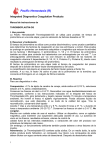



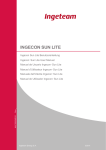
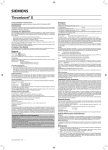

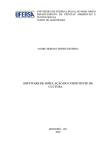
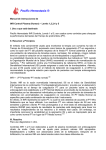


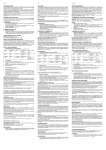
![[APTT-SiL Minus]. - Agentúra Harmony vos](http://vs1.manualzilla.com/store/data/006356908_1-375f15e67189b727c91a121fb0458e7e-150x150.png)
